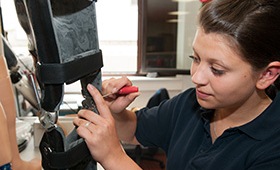High degree of occupational commitment amongst young working population
BIBB analysis on career changes following apprenticeships
17/2015 | Bonn, 21.04.2015

More than half of the working population in the age group of 18 to 24 years who hold dual system vocational training qualifications work in their original field of training (52%). 32% work in an occupation that is at least related to their original vocational education and training course. These high percentages are indicative of the flexible employment of company-trained apprenticeship graduates in the labour market. According to the subjective assessment of the group of young gainfully employed people in the survey, only an average of 16% of young people in this age group work in a field that has nothing to do with the occupation they were trained in. Of these job changers, 65% can use only very little to none of the skills they have initially learnt.
These are the results of a survey by the German Federal Institute for Vocational Education and Training (BIBB) based on the BIBB/BAuA-Jugenderwerbstätigenbefragung 2011/2012 (survey amongst the young working population) published in the current issue of the BIBB specialist periodical "Vocational Training in Research and Practice – BWP".
The BIBB analysis reveals that the number of young people to fully change careers increases with the time that has passed since their apprenticeship graduation. Of those who completed their apprenticeship in 2012, only some 4% worked outside their original training occupation at the time of the survey, which has also to do with the option of being offered a permanent contract by the business providing their vocational training. Of those who graduated in 2011, about 12% have fully changed their career paths and this percentage rises to 19% for those who completed their apprenticeship in 2010.
Differentiation according to school qualifications reveals that lower secondary school graduates account for the highest career change percentage (about 24%). The career change rate is about 13% for those with higher school-leaving qualifications. Men more often change their training occupation (about 18%) than women (nearly 13%).
Also, those who have been apprenticed in the skilled trades significantly more often change their careers than those who have been apprenticed in the industry (21% compared to 11%). Also, a similarly high percentage of the working population who have trained in small businesses change their occupations (about 20%). In other words, the vocational education and training provision following demand, as it often is found in the skilled trades and small businesses, has an effect not only on the prospect of permanent employment after the apprenticeship, but also on the career change rate.
The consequences of changing one's career path are decisively dependent on whether the job change was voluntary, for example, due to higher wages in the new occupation or as a result of changed occupational interest, or involuntary, for example, because of a failure to find employ-ment in the training occupation due to unfavourable employment opportunities. Empirical ob-servation on the basis of the 2006 BIBB/BAuA survey amongst the working population reveals that only involuntary and complete job changes go hand in hand with a significantly reduced income. People who work in a related occupation on average do not suffer reduced income rates compared to those who continue to work in the occupation they trained for.
The 2011/2012 survey amongst the young working population carried out by the BIBB and the German Federal Institute for Occupational Safety and Health (BAuA) is a representative telephone survey involving more than 3,200 young gainfully employed people and apprentices between 15 and 24 years of age with working or training hours of at least ten hours per week.
More information available in the report "Change of occupation after training: 18- bis 24-year old's with dual vocational education and training in working life" in: BWP Issue 2/2015. Article available for free download.
Images are available under www.bibb.de/pressefotos.
Contact at the BIBB:
Dr. Anja Hall
Specimen copy requested.